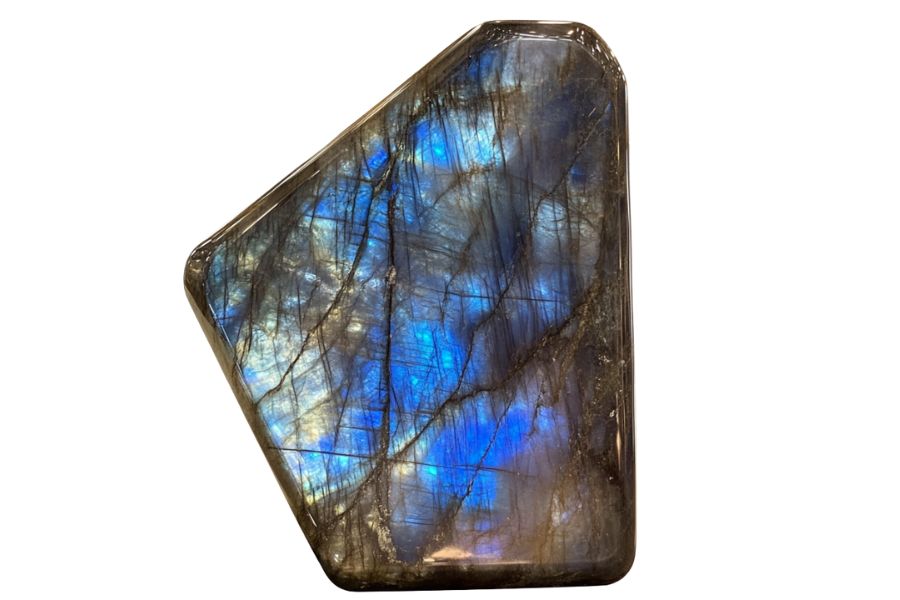Hunting for labradorite in Arizona can be a fun weekend activity. But it’s not always easy to know where to start. Many rockhounds spend hours driving to spots only to come back empty-handed.
I’ve been there too. After wasting gas money and time on my first few trips, I learned which areas in Arizona actually have labradorite. Some places have better quality stones than others, and some spots are more beginner-friendly.
You don’t need to make the same mistakes I did. Here, I’ll share real spots where you can find labradorite today. No old, picked-over locations, just current places where you can still find good pieces.
How Labradorite Forms Here
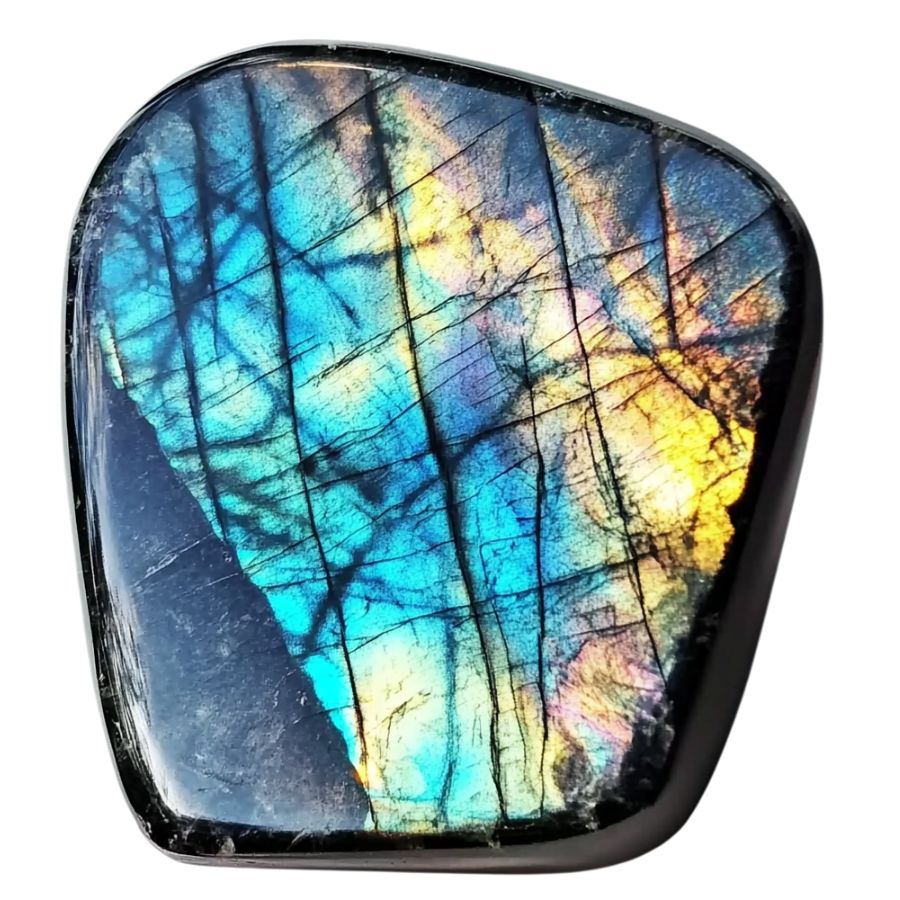
Labradorite forms deep underground when magma slowly cools and crystallizes. The process happens when different minerals separate while cooling, creating thin layers stacked on top of each other. These layers have slightly different chemical makeups, usually about 1 micron thick.
When light hits these layers, it creates that stunning blue-green flash we love, called labradorescence. The stone starts out as a mix of calcium, sodium, aluminum, and silicate minerals.
As it cools, these minerals organize themselves into this layered pattern, which happens most often in places where magma intrudes into the surrounding rock. It’s like nature’s own light show, frozen in stone.
Types of Labradorite
Labradorite comes in several distinct varieties. Each type exhibits special qualities that make it sought after by collectors.
Blue Labradorite
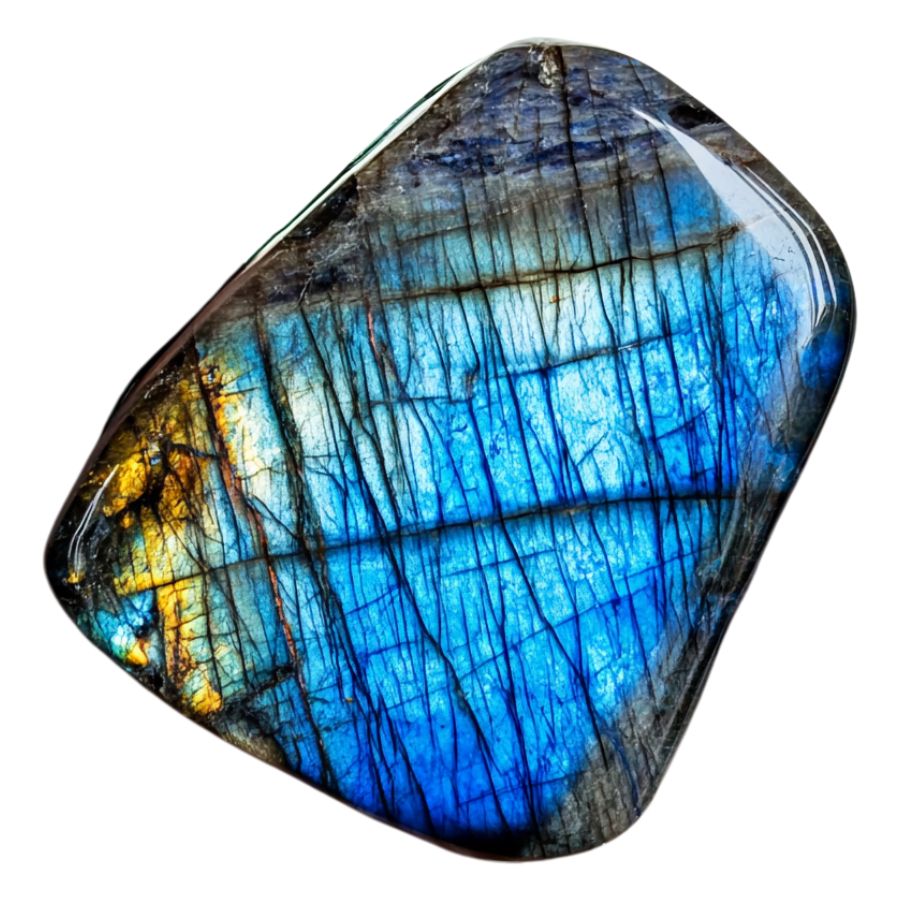
Blue Labradorite stands out for its remarkable blue iridescence against a dark gray or black background. When light hits the stone’s surface, it creates a stunning display of electric blue flashes, sometimes accompanied by hints of green or violet.
The blue flashes appear most vivid when viewing the stone from specific angles, creating an almost magical transformation as you rotate it. This effect is often compared to the ethereal beauty of the Northern Lights.
Exceptional specimens display an intense, electric blue flash that covers a large portion of the stone’s surface. Some pieces also show secondary colors like aqua or sea green, adding depth to their visual appeal. The contrast between the dark base and bright blue flashes makes each piece unique.
Golden Labradorite

Golden Labradorite displays a mesmerizing golden-yellow sheen that sets it apart from other varieties. The stone’s surface exhibits brilliant flashes of gold and amber, creating a warm, sun-like glow that seems to emanate from within. These golden rays often appear alongside subtle hints of green or champagne colors.
What makes Golden Labradorite special is its ability to display multiple golden hues simultaneously. Some specimens show a range of colors from pale yellow to deep amber, creating a multi-dimensional effect.
The golden flash can vary in intensity and coverage, with premium specimens showing broad, bright areas of gold schiller.
Rainbow Moonstone
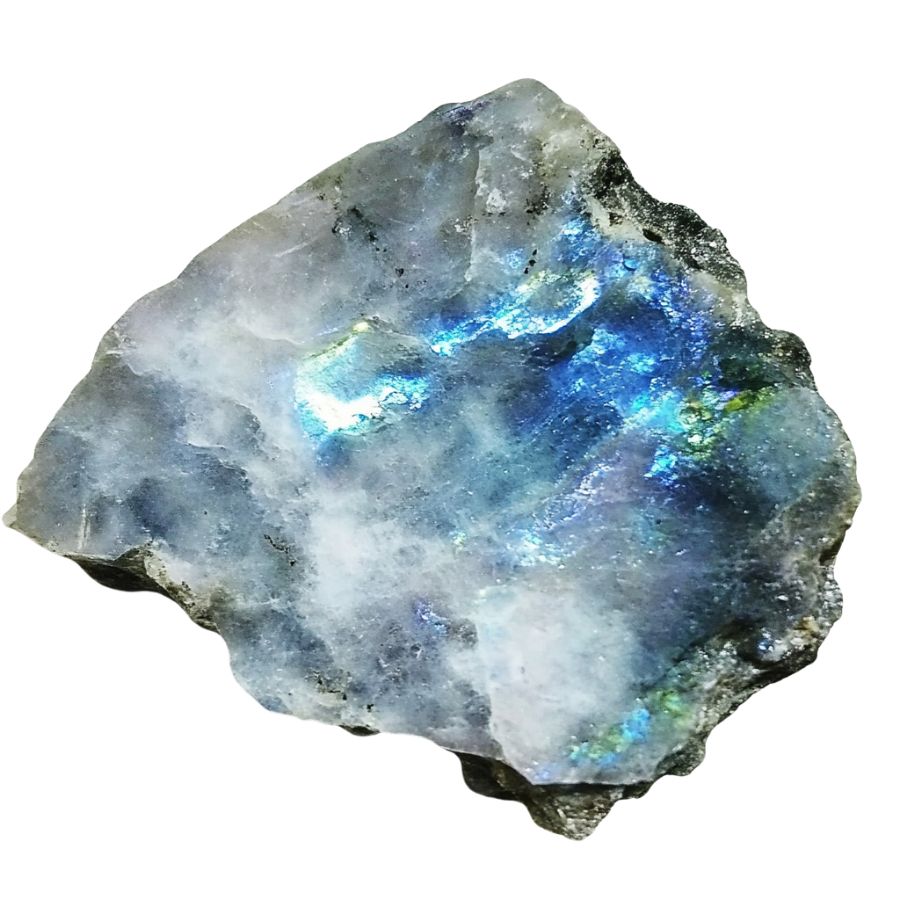
Rainbow Moonstone Labradorite exhibits a distinctive white or colorless base with an enchanting blue sheen that floats across its surface. Blue sheen is often accompanied by flashes of other colors, including pink, yellow, and green.
This stone’s most captivating feature is how its colors appear to float just beneath the surface, creating an almost three-dimensional effect. As light moves across the stone, these colors shift and change, revealing new patterns and combinations. This creates a dynamic display that seems to change with every movement.
The stone’s transparency can range from translucent to semi-transparent, with the most valued pieces showing excellent clarity beneath their shimmering surface.
Spectrolite
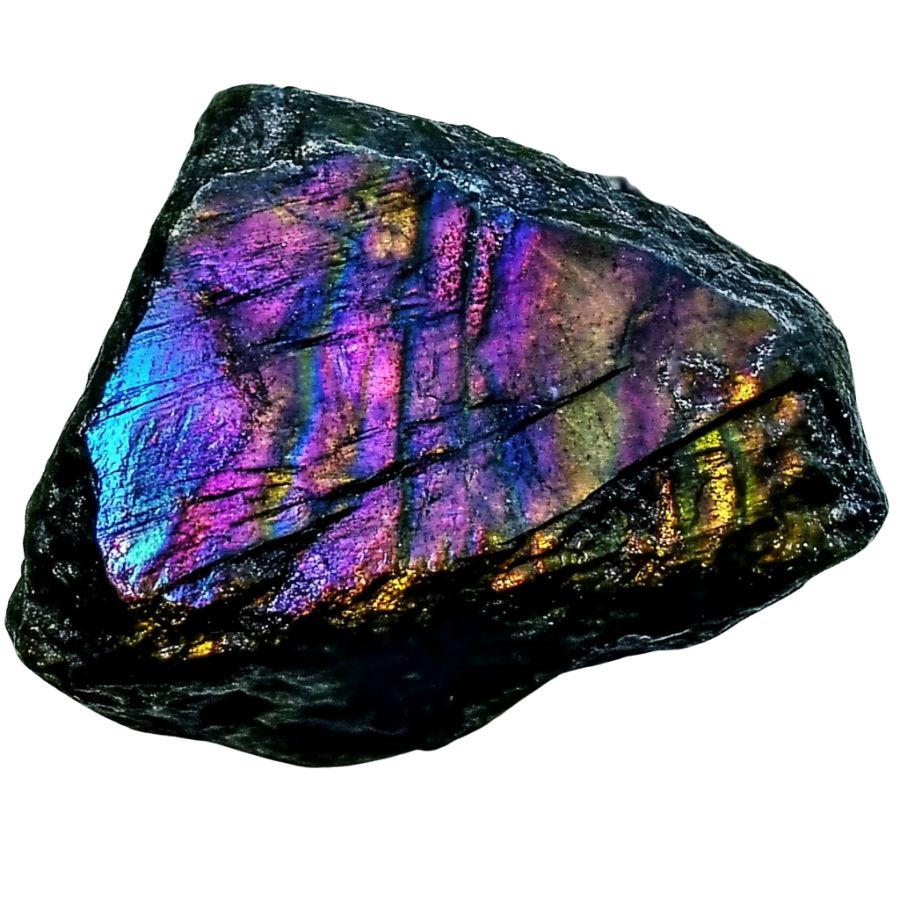
Spectrolite reigns as the most dramatic member of this stone family, with its distinctive jet-black base setting it apart from other varieties.
What makes it truly special is that premium specimens can simultaneously display the complete spectrum of colors, from deep indigo to bright orange, emerald green to royal purple, all in a single piece.
The finest specimens possess what experts call “full-face color,” meaning the vibrant display covers most of the stone’s surface rather than appearing in small patches.
This characteristic, combined with its remarkable color intensity, has earned Spectrolite its reputation as the most visually impressive variety of all similar stones.
Transparent Labradorite
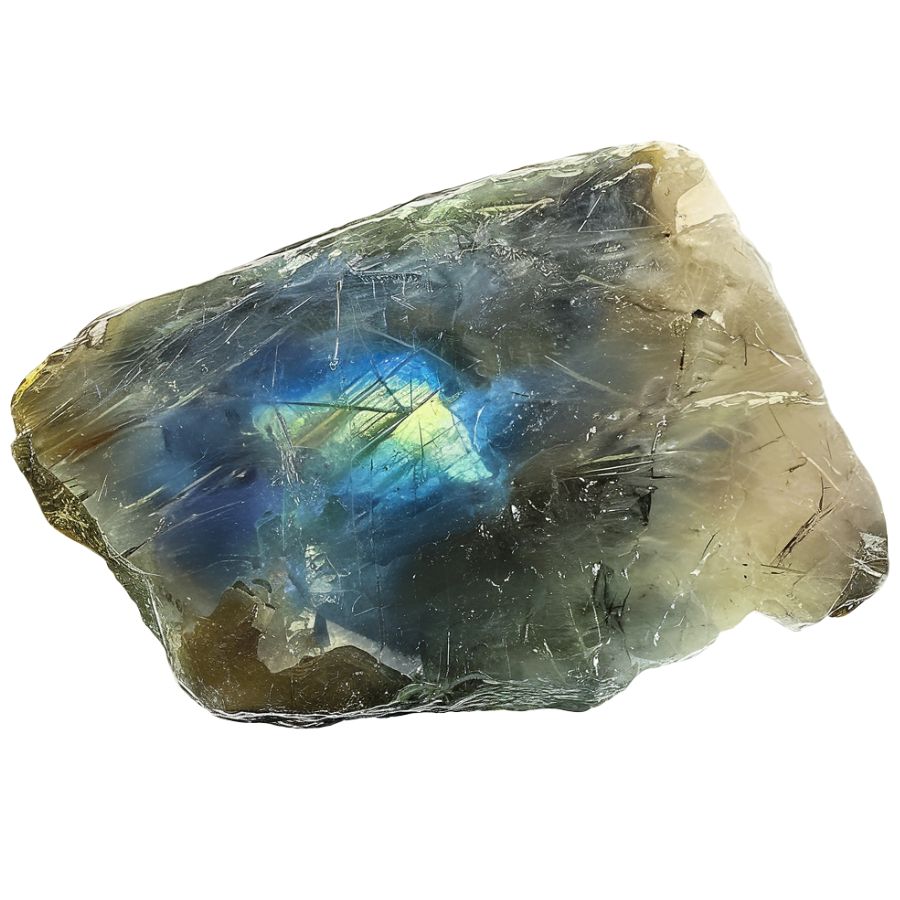
Transparent Labradorite exhibits a remarkable clarity that separates it from its opaque cousins. Crystal-clear areas allow light to pass through, creating an exceptional display of blue flashes against the transparent background.
Natural specimens often show areas of both transparency and translucency. Beautiful color changes occur as you move this stone, with the transparent areas revealing subtle blue sheens that seem to float within the crystal.
Some pieces display additional colors like soft greens or pale yellows, though the blue flash remains dominant.
Remarkable clarity combines with the signature color play to create stones that appear almost liquid-like.
Andesine-Labradorite
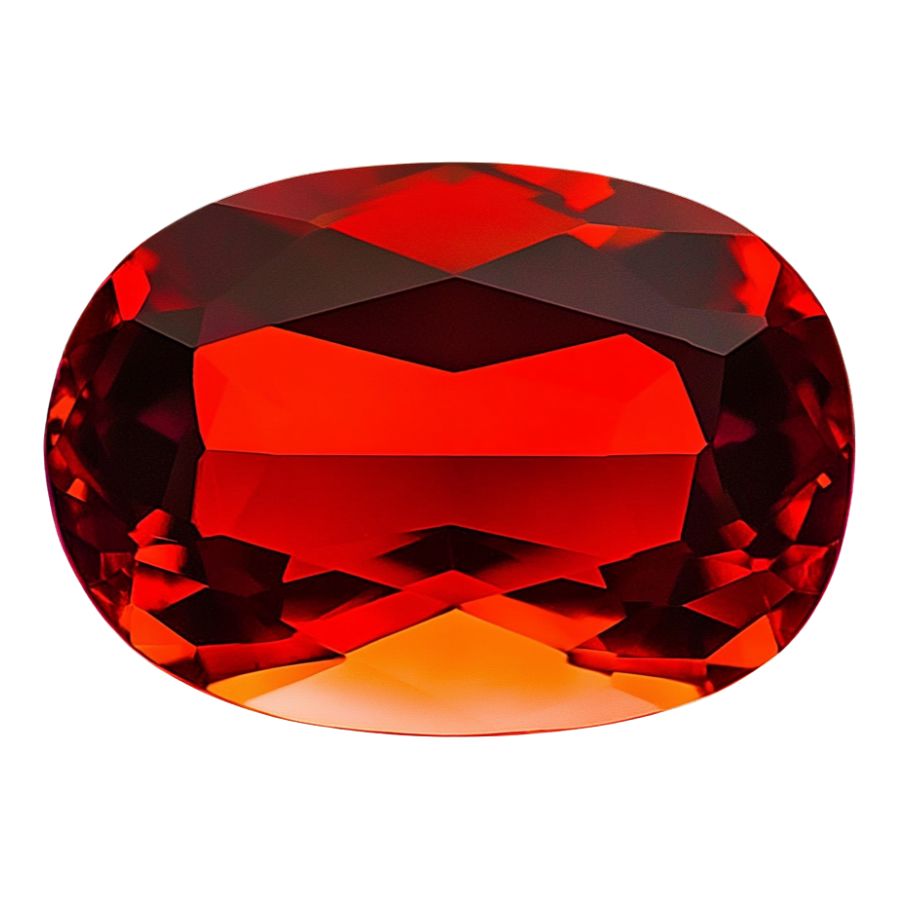
Reddish-orange hues dominate Andesine-Labradorite’s appearance, creating a warm and inviting glow. Delicate green and yellow streaks often appear throughout the stone, adding complexity to its color palette.
Metallic sparkles dance across the surface, different from the typical labradorescent effect. Fresh discoveries of this relatively new gemstone continue to reveal new color combinations.
Striking color variations appear in high-quality pieces, ranging from deep red to bright orange. Many specimens show subtle color zoning, where different hues blend together in distinct patterns.
Black Labradorite
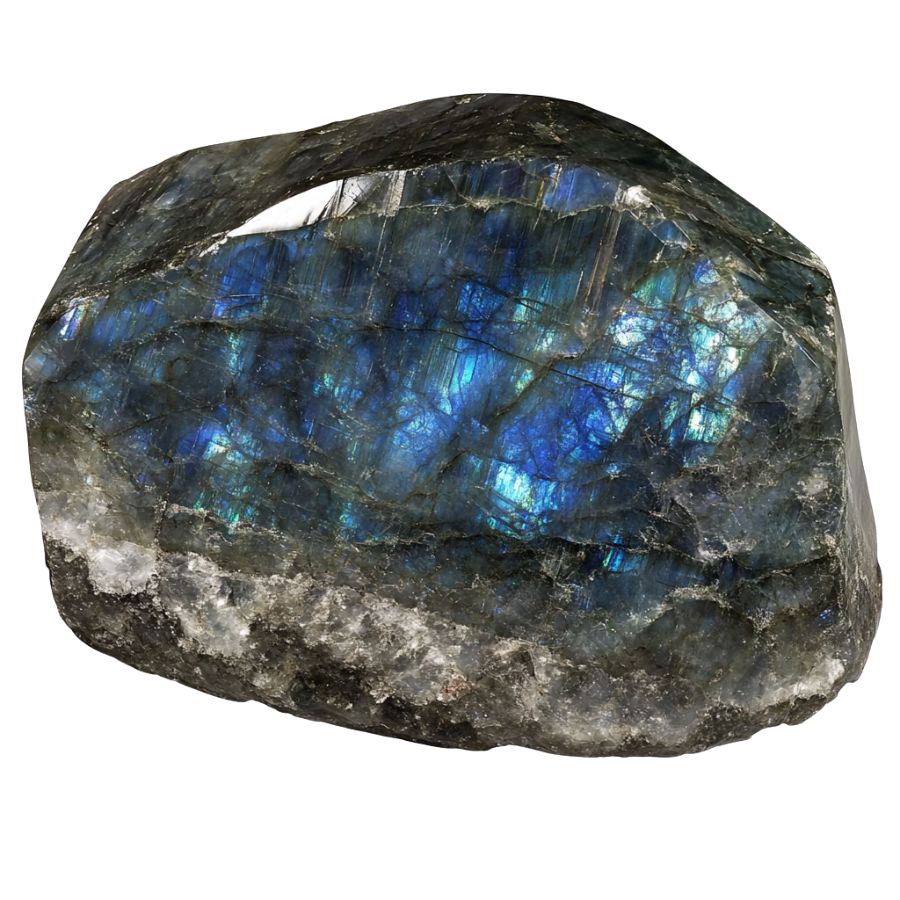
Black Labradorite presents a dramatic dark canvas that emphasizes its colorful display. Bright flashes of color stand out dramatically against the deep black background, creating stunning visual contrast.
Most specimens show multiple colors at once, creating an eye-catching display. These color displays often include electric blues, emerald greens, and golden yellows, all visible simultaneously.
Natural sunlight brings out the boldest displays, while artificial light can highlight subtle color variations. Some specimens also show interesting patterns in how the colors are distributed.
Brown Labradorite

Brown Labradorite features rich earth tones ranging from deep chocolate to warm amber. Peach and orange undertones often appear throughout the stone, creating depth and dimension.
Multiple color zones create interesting patterns within each stone. These patterns can include stripes, swirls, or mottled areas that combine different brown and orange hues.
Subtle iridescence sometimes appears on the surface, adding an unexpected shimmer to the earthy colors. This effect is more subdued than in other varieties but adds an interesting dimension to the stone’s appearance.
If you want REAL results finding incredible rocks and minerals you need one of these 👇👇👇
Finding the coolest rocks in isn’t luck, it's knowing what to look for. Thousands of your fellow rock hunters are already carrying Rock Chasing field guides. Maybe it's time you joined the community.
Lightweight, mud-proof, and packed with clear photos, it’s become the go-to tool for anyone interested discovering what’s hidden under our red dirt and what they've already found.
Join them, and make your next rockhounding trip actually pay off.
What makes it different:
- 📍 Find and identify 140 incredible crystals, rocks, gemstones, minerals, and geodes across the USA
- 🚙 Field-tested across America's rivers, ranchlands, mountains, and roadcuts
- 📘 Heavy duty laminated pages resist dust, sweat, and water
- 🧠 Zero fluff — just clear visuals and straight-to-the-point info
- ⭐ Rated 4.8★ by real collectors who actually use it in the field
What Rough Labradorite Looks Like
Labradorite in its rough form can be tricky to spot, but once you know what to look for, it becomes easier. Here’s how to recognize this fascinating stone in its natural state.
Look for the Signature Flash
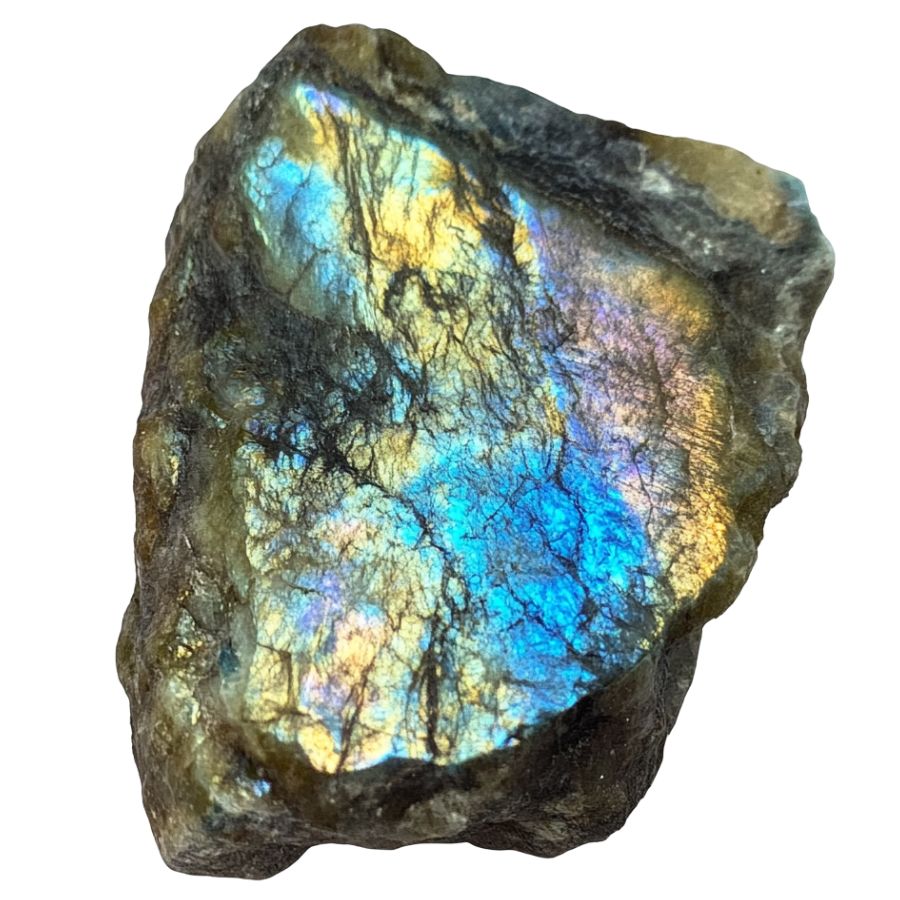
Raw labradorite often shows patches of its famous iridescent flash, even when unpolished. Check dark gray or black areas under direct sunlight – you might catch glimpses of blue, green, or gold shimmer.
Sometimes, you’ll need to wet the surface slightly to see this effect better. The flash isn’t always obvious but usually appears as scattered patches.
Check the Base Color and Texture
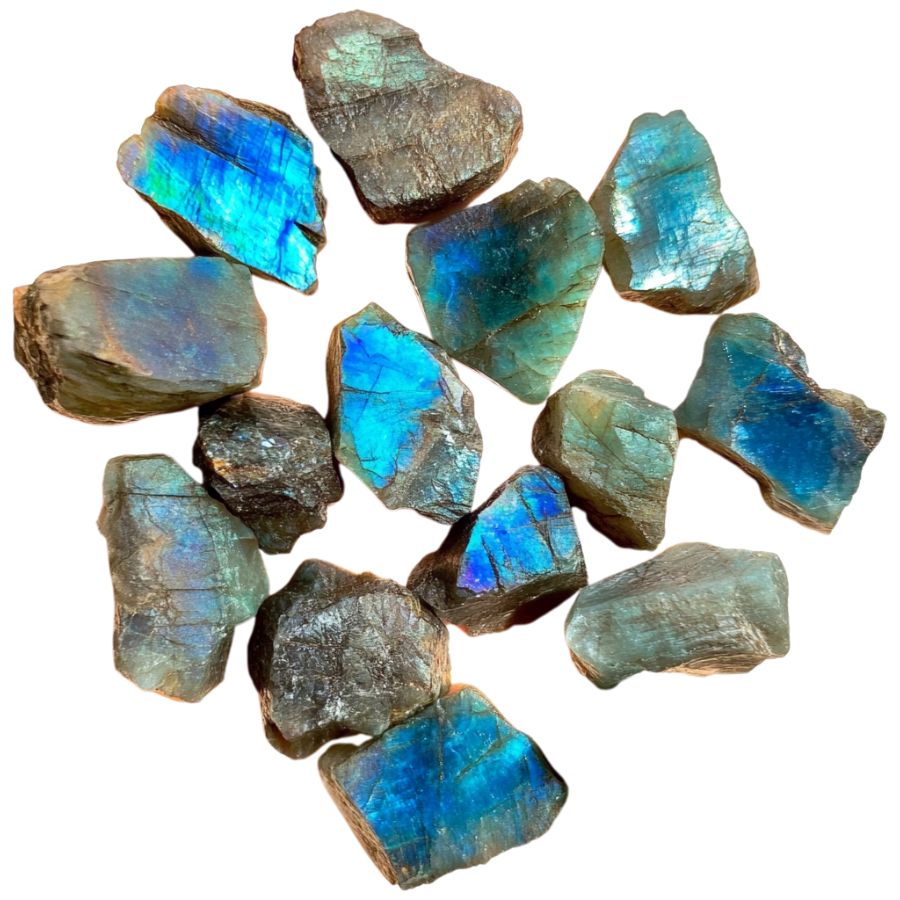
The main body should be dark gray to black, sometimes with a slight greenish tinge. The surface feels smooth but not glossy, similar to unpolished glass.
Look for a slightly bumpy texture with occasional flat surfaces. Fresh breaks will show a more uniform color than weathered surfaces.
Assess the Hardness and Breakage
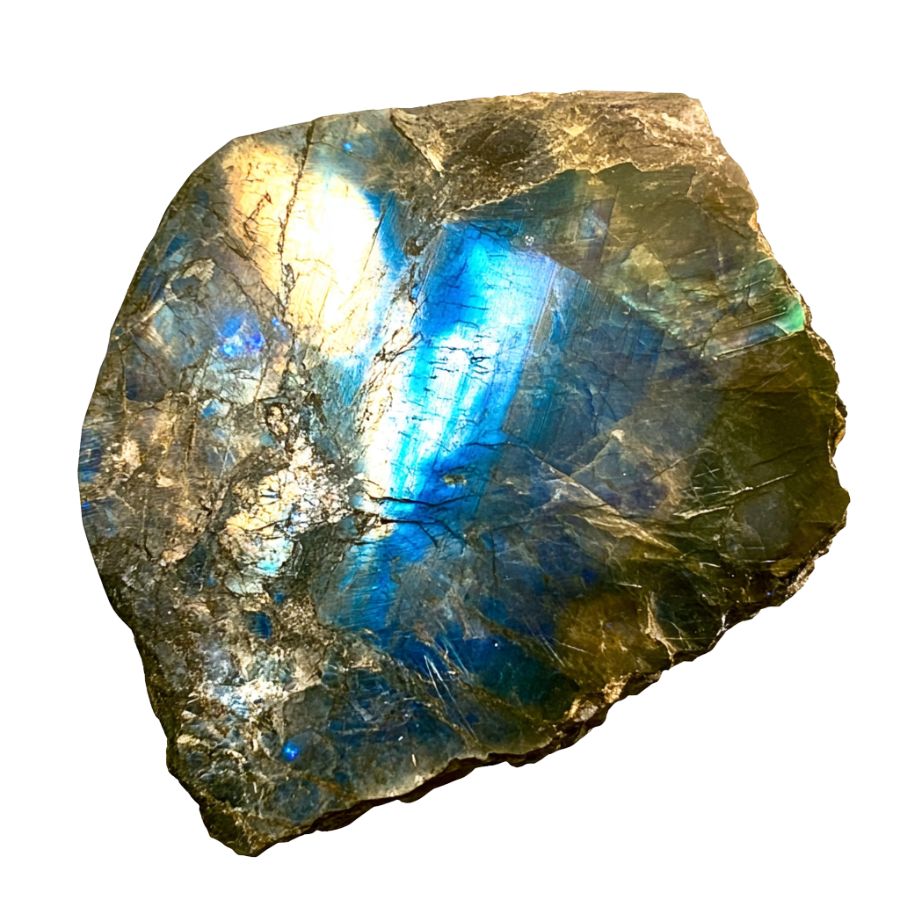
Try scratching the surface with a copper penny – it shouldn’t leave a mark. The stone often breaks with smooth, flat surfaces at distinct angles.
You’ll notice these angular breaks are pretty characteristic, unlike random rough breaks in common rocks.
Test the Translucency

Hold a thin edge up to strong light. Raw labradorite should show some translucency, appearing slightly cloudy rather than completely opaque. The edges might look slightly whitish or gray when light passes through. Thicker pieces will appear darker and more opaque.
A Quick Request About Collecting
Always Confirm Access and Collection Rules!
Before heading out to any of the locations on our list you need to confirm access requirements and collection rules for both public and private locations directly with the location. We haven’t personally verified every location and the access requirements and collection rules often change without notice.
Many of the locations we mention will not allow collecting but are still great places for those who love to find beautiful rocks and minerals in the wild without keeping them. We also can’t guarantee you will find anything in these locations since they are constantly changing.
Always get updated information directly from the source ahead of time to ensure responsible rockhounding. If you want even more current options it’s always a good idea to contact local rock and mineral clubs and groups
Tips on Where to Look
Labradorite isn’t super common in everyday places, but with some smart searching, you can find it. Here’s where you should look:
Metamorphic Rock Formations
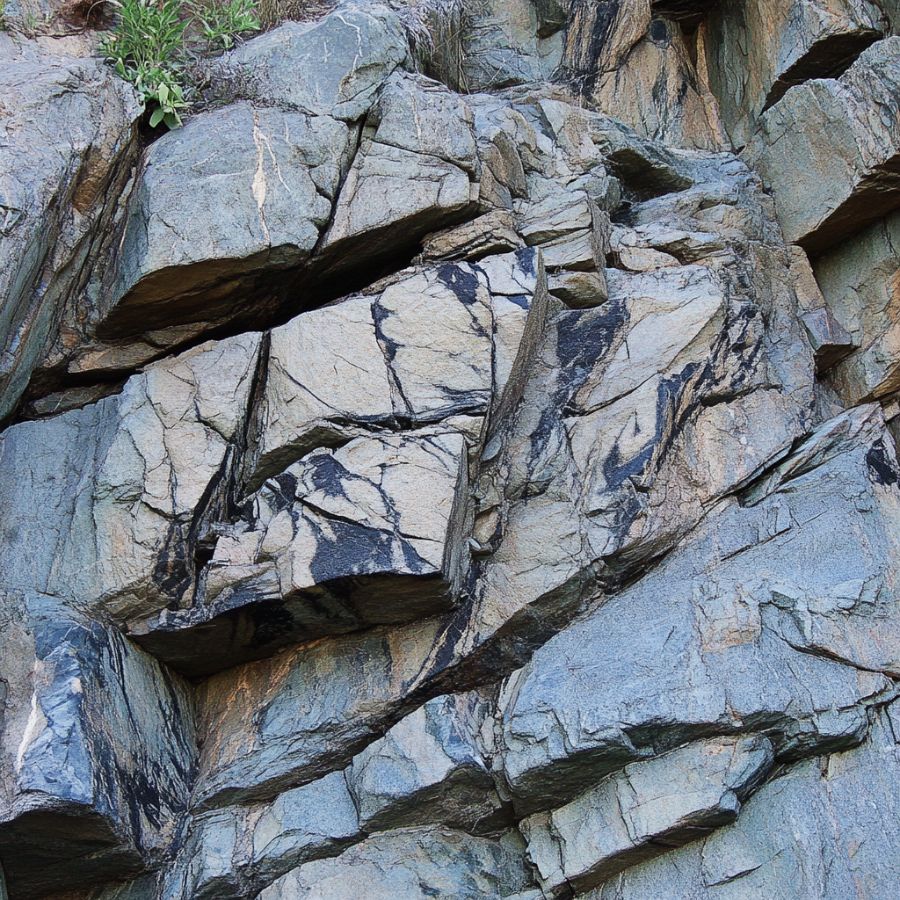
Look for dark-colored rock outcrops. Spot areas with lots of feldspar minerals. Check exposed cliff faces. Sometimes, when the sun hits just right, you might catch that signature blue flash from larger formations that’s a dead giveaway for labradorite presence.
Glacial Deposits
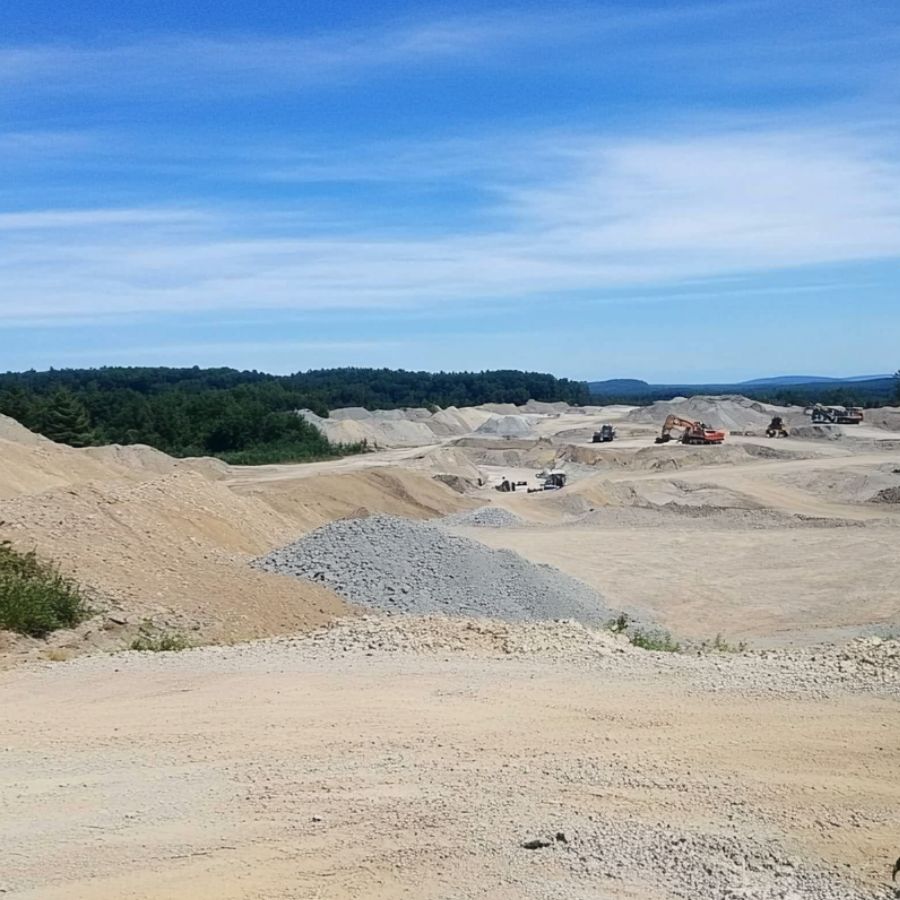
Search river beds after glacial deposits. Check gravel pits near old glacial paths. Look for smooth, dark gray stones mixed with other rocks. These deposits often contain chunks of labradorite that have broken off from larger formations and been carried downstream over thousands of years.
Mining Tailings
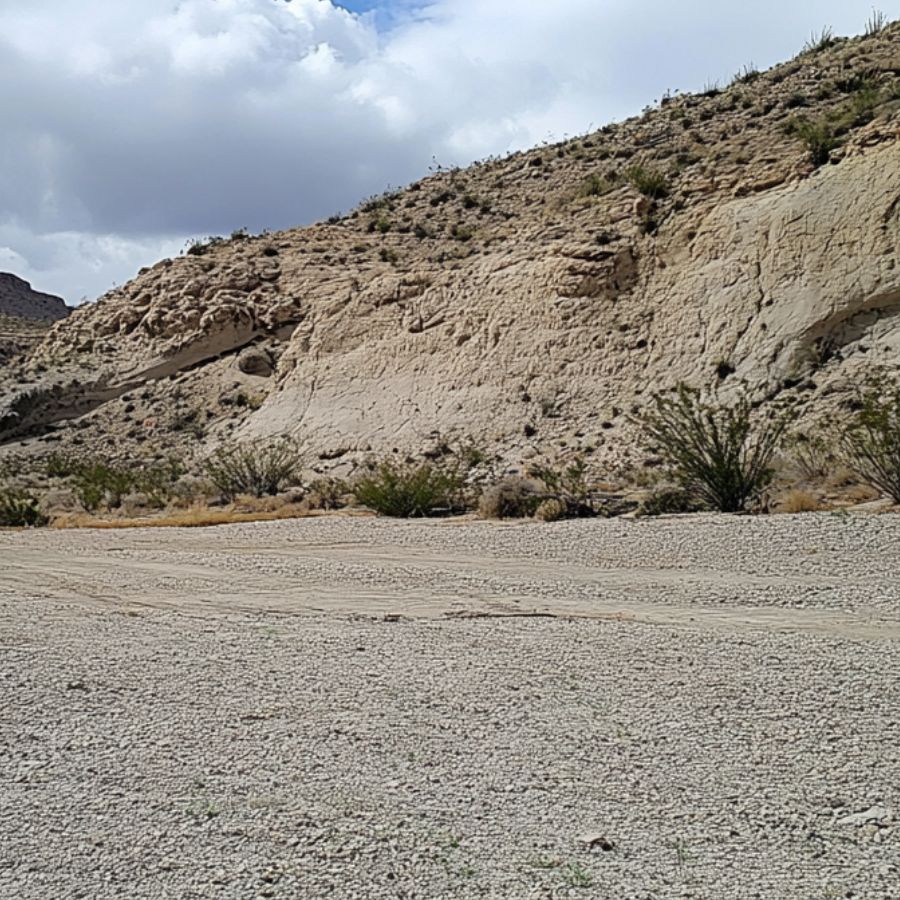
Visit abandoned feldspar mines. Check mine dump areas. Dig through tailings piles. Look for flat, shiny surfaces. The waste rock from old mining operations often contains overlooked pieces of labradorite that weren’t considered valuable during active mining periods but are perfect for collectors.
Stream Beds

Search clear-water streams. Look under water-worn rocks. Check gravel bars after rain. Spot dark, plate-like stones. The constant water movement often exposes and polishes these stones, making them easier to identify when wet.
Some Great Places To Start
Here are some of the better places in the state to start looking for Labradorite:
Always Confirm Access and Collection Rules!
Before heading out to any of the locations on our list you need to confirm access requirements and collection rules for both public and private locations directly with the location. We haven’t personally verified every location and the access requirements and collection rules often change without notice.
Many of the locations we mention will not allow collecting but are still great places for those who love to find beautiful rocks and minerals in the wild without keeping them. We also can’t guarantee you will find anything in these locations since they are constantly changing.
Always get updated information directly from the source ahead of time to ensure responsible rockhounding. If you want even more current options it’s always a good idea to contact local rock and mineral clubs and groups
Dos Cabezas Mountains

The Dos Cabezas Mountains stand in southeastern Arizona, within Cochise County. These mountains got their Spanish name, meaning “Two Heads”, because of their twin granite peaks that rise from the desert floor.
Located about 20 miles east of Willcox, this range is part of the Sonoran Desert region. The area’s rich geological makeup includes both igneous and metamorphic rocks, creating perfect conditions for labradorite formation.
You can find this colorful gemstone in granite outcrops and areas with exposed anorthosite bodies. The best spots are typically at higher elevations or near old mine dumps where deeper rock layers have been brought to the surface.
The mountain’s volcanic history has created diverse mineral deposits throughout the range. Many rockhounds explore the mountain’s quarries and gravel beds, as these areas often contain labradorite specimens.
Galiuro Mountains
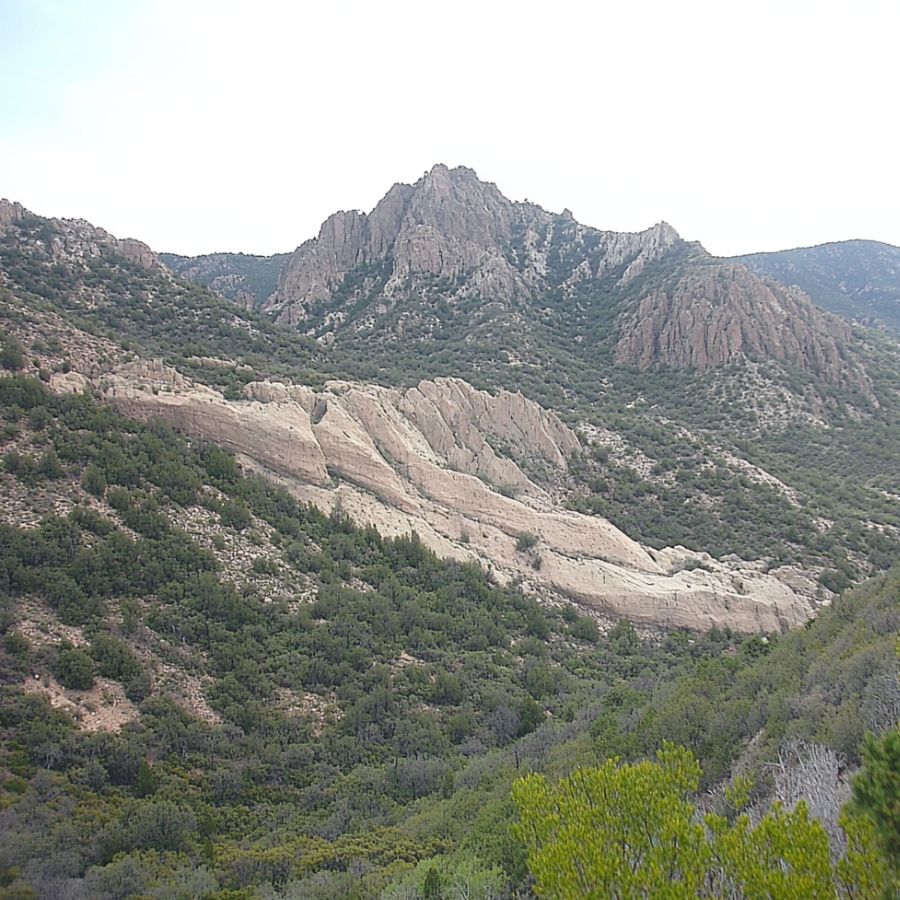
The Galiuro Mountains stretch across southeastern Arizona, spanning parts of Graham, Pinal, and Pima counties. These rugged mountains sit between the San Pedro River Valley and Aravaipa Valley, with Bassett Peak standing as the highest point at 7,671 feet.
Volcanic activity shaped these mountains millions of years ago during the Oligocene-Miocene period. This volcanic history created perfect conditions for mineral formation, including labradorite and other feldspar minerals.
Focus on areas with exposed volcanic rocks. Whitewash Canyon offers excellent opportunities with its clear layers of volcanic deposits. Here, the ash-flow tuffs and rhyolitic flows contain various minerals formed during cooling and crystallization.
Table Mountain and Aravaipa Canyon also provide good spots for finding labradorite specimens.
Black Mountain
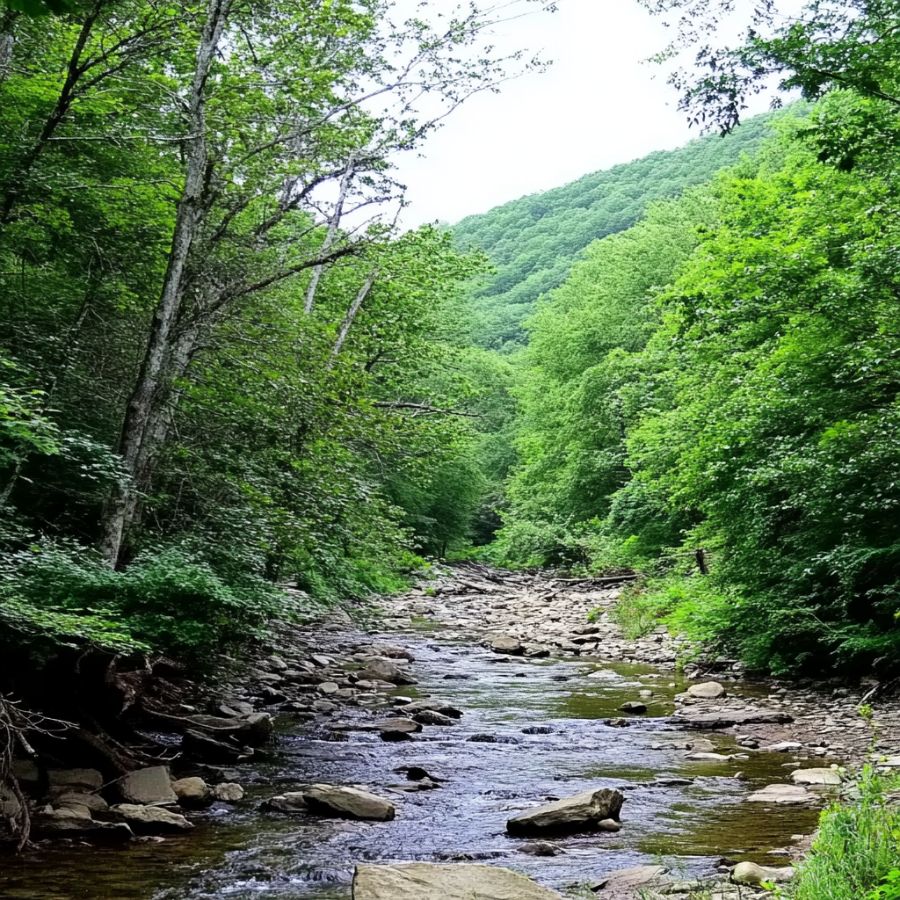
Black Mountain is a rugged peak in Maricopa County, Arizona, located between the towns of Carefree and Cave Creek. Rising to 3,403 feet, it stands out with its dark profile against the desert landscape.
The mountain features two main rock types that make it special for rockhounds. The western side has meta-sedimentary rocks like phyllite and argillite. These rocks show layered patterns from ancient processes. The eastern side contains granite with large crystals that sparkle in the sunlight.
Explore the granite areas of Black Mountain. Look for the boundary zones where granite meets the other rock types. These transition areas often hold the best specimens. The feldspar-rich pockets within the granite formation are prime spots for finding this colorful gem.
Weather has broken down the mountain’s surface over time, exposing mineral deposits. Serious collectors visit after rain when the stones appear cleaner and their colors shine more brightly against the darker backdrop.
Mowry

Mowry is a historic mining town in Santa Cruz County, located in the Patagonia Mountains about 16 miles south of Patagonia town. This rugged area sits at an elevation of around 5,466 feet, close to the Mexican border.
The geology of Mowry is special because it’s part of the Patagonia Mining District, famous for its rich mineral deposits. Old silver, lead, and zinc mines operated here in the past, creating exposed rock areas perfect for gem hunting today.
You can find labradorite in Mowry’s igneous rock formations, especially in areas containing basalt and gabbro. These dark rocks often host flashy labradorite crystals. Mine dumps and old quarry sites offer good hunting grounds for specimens.
Serious rockhounds should look for rocks with visible feldspar content, as these might contain the sought-after labradorite with its distinctive blue-green flash called “labradorescence.”
Kingman
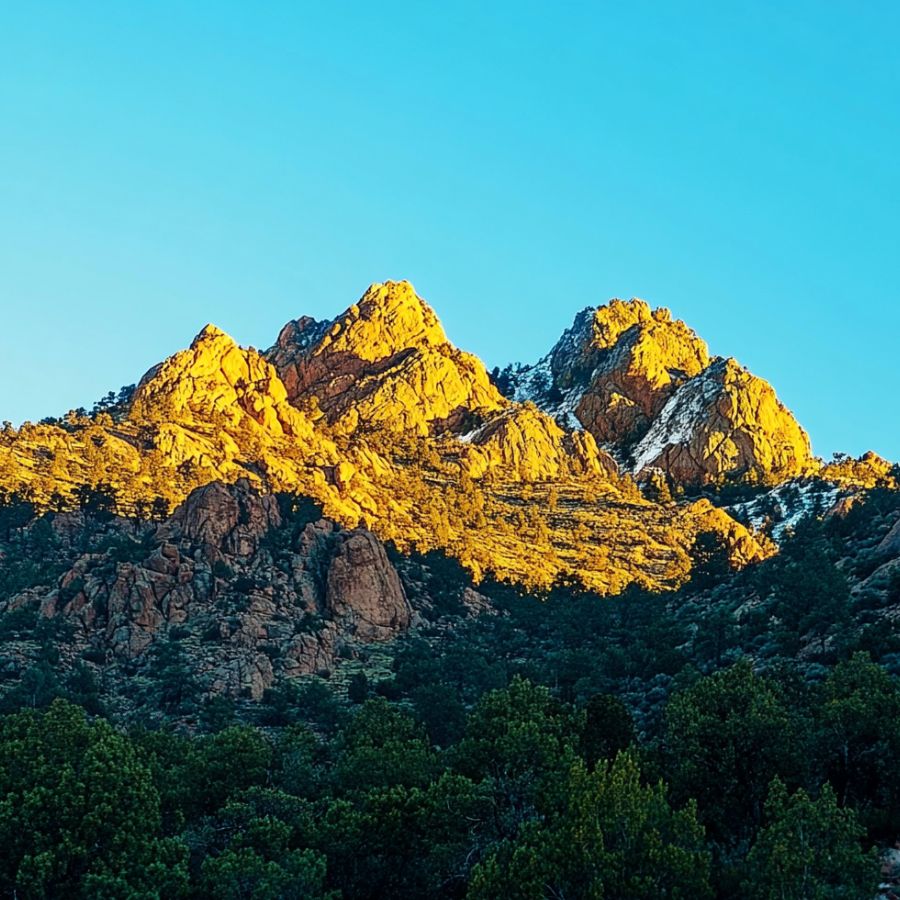
Kingman is located in northwestern Arizona, near the Cerbat Mountains. This area has rugged terrain with mountains, valleys, and desert landscapes. The nearby Hualapai Mountains add beauty to this rock-hounding destination.
The area’s volcanic history makes Kingman special for gemstone hunters. Ancient rock formations throughout Mohave County contain various minerals, including labradorite.
Rockhounds should explore the exposed igneous rock formations around Kingman for labradorite specimens. Local quarries and mine dumps often yield good finds. Some collectors have success searching in gravel beds near seasonal waterways. The granite outcrops in the region also hold promise for finding this gemstone.
Kingman’s accessibility makes it popular with both beginner and experienced collectors seeking labradorite.
Places Labradorite has been found by County
After discussing our top picks, we wanted to discuss the other places on our list. Below is a list of the additional locations along with a breakdown of each place by county.
| County | Location |
| Cochise | Bisbee |
| Pima | Pima Mining District |
| Cochise | Graham Mountains-Fisher Hills area |
| Cochise | Southern Terminus of Winchester Mountains |
| Pima | Cienega Gap area |
| Pima | Mineta Ridge area |
| Pima | Sentinel Peak (‘A’ Mountain) – SW side |
| Yavapai | Boulder Creek |
| Pinal | Superstition Mountain |
| Maricopa | Wickenburg |
| Greenlee | Morenci |
| Yavapai | Bagdad |
| Maricopa | Hieroglyphic Mountains |
| Maricopa | Tonopah |
| Navajo | Woodruff |
| Navajo | Holbrook |
| Navajo | Winslow |
| Gila | Globe |
| Maricopa | Cave Creek |
| Greenlee | Clifton |
| Maricopa | Morristown |
| Yavapai | Sedona |

